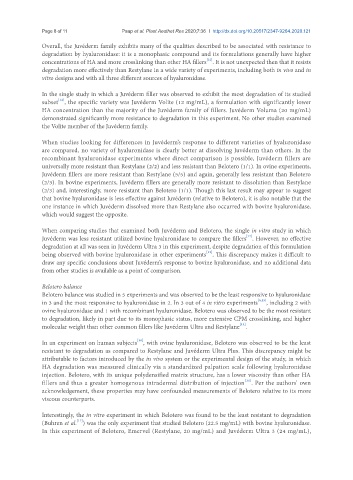Page 398 - Read Online
P. 398
Page 8 of 11 Paap et al. Plast Aesthet Res 2020;7:36 I http://dx.doi.org/10.20517/2347-9264.2020.121
Overall, the Juvéderm family exhibits many of the qualities described to be associated with resistance to
degradation by hyaluronidase: it is a monophasic compound and its formulations generally have higher
[22]
concentrations of HA and more crosslinking than other HA fillers . It is not unexpected then that it resists
degradation more effectively than Restylane in a wide variety of experiments, including both in vivo and in
vitro designs and with all three different sources of hyaluronidase.
In the single study in which a Juvéderm filler was observed to exhibit the most degradation of its studied
[14]
subset , the specific variety was Juvéderm Volite (12 mg/mL), a formulation with significantly lower
HA concentration than the majority of the Juvéderm family of fillers. Juvéderm Voluma (20 mg/mL)
demonstrated significantly more resistance to degradation in this experiment. No other studies examined
the Volite member of the Juvéderm family.
When studies looking for differences in Juvéderm’s response to different varieties of hyaluronidase
are compared, no variety of hyaluronidase is clearly better at dissolving Juvéderm than others. In the
recombinant hyaluronidase experiments where direct comparison is possible, Juvéderm fillers are
universally more resistant than Restylane (2/2) and less resistant than Belotero (1/1). In ovine experiments,
Juvéderm fillers are more resistant than Restylane (5/5) and again, generally less resistant than Belotero
(2/3). In bovine experiments, Juvéderm fillers are generally more resistant to dissolution than Restylane
(2/3) and, interestingly, more resistant than Belotero (1/1). Though this last result may appear to suggest
that bovine hyaluronidase is less effective against Juvéderm (relative to Belotero), it is also notable that the
one instance in which Juvéderm dissolved more than Restylane also occurred with bovine hyaluronidase,
which would suggest the opposite.
When comparing studies that examined both Juvéderm and Belotero, the single in vitro study in which
[17]
Juvéderm was less resistant utilized bovine hyaluronidase to compare the fillers . However, no effective
degradation at all was seen in Juvéderm Ultra 3 in this experiment, despite degradation of this formulation
[12]
being observed with bovine hyaluronidase in other experiments . This discrepancy makes it difficult to
draw any specific conclusions about Juvéderm’s response to bovine hyaluronidase, and no additional data
from other studies is available as a point of comparison.
Belotero balance
Belotero balance was studied in 5 experiments and was observed to be the least responsive to hyaluronidase
in 3 and the most responsive to hyaluronidase in 2. In 3 out of 4 in vitro experiments [6,15] , including 2 with
ovine hyaluronidase and 1 with recombinant hyaluronidase, Belotero was observed to be the most resistant
to degradation, likely in part due to its monophasic status, more extensive CPM crosslinking, and higher
[15]
molecular weight than other common fillers like Juvéderm Ultra and Restylane .
[18]
In an experiment on human subjects , with ovine hyaluronidase, Belotero was observed to be the least
resistant to degradation as compared to Restylane and Juvéderm Ultra Plus. This discrepancy might be
attributable to factors introduced by the in vivo system or the experimental design of the study, in which
HA degradation was measured clinically via a standardized palpation scale following hyaluronidase
injection. Belotero, with its unique polydensified matrix structure, has a lower viscosity than other HA
[31]
fillers and thus a greater homogenous intradermal distribution of injection . Per the authors’ own
acknowledgement, these properties may have confounded measurements of Belotero relative to its more
viscous counterparts.
Interestingly, the in vitro experiment in which Belotero was found to be the least resistant to degradation
[17]
(Buhren et al. ) was the only experiment that studied Belotero (22.5 mg/mL) with bovine hyaluronidase.
In this experiment of Belotero, Emervel (Restylane, 20 mg/mL) and Juvéderm Ultra 3 (24 mg/mL),

